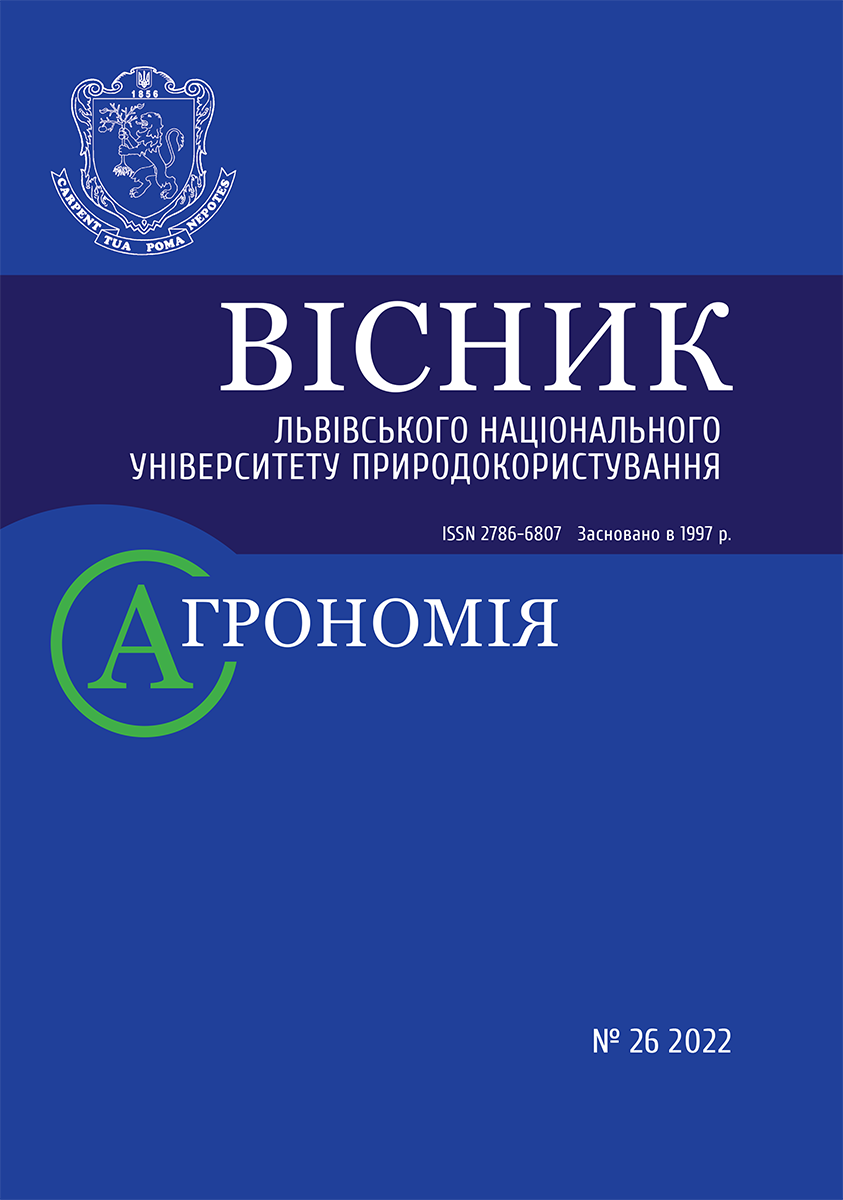BREEDS OF UKRAINIAN SELECTION AND THEIR PRODUCTIVITY IN THE CONDITIONS OF WESTERN FOREST STEPPE
DOI:
https://doi.org/10.31734/agronomy2022.26.128Keywords:
breed, soybean, productivity, harvesting, quality indicatorsAbstract
This article covers the list of precocious soybean varieties (Ukrainian Selection) for the purpose of studying them in the conditions of Western Forest-Steppe zone of Ukraine. The research was conducted during 2017–2020 at the experimental field of Crop Production Technology Department of the Lviv National Environmental University.
In these studies, the following soybean varieties were used, namely Ustia, Khvylia, Muza, Arnica, Vilshanka, Siverka, Suziria, Vyshyvanka, originated by the Institute of NSC «Agriculture of the National Academy of Sciences». These varieties belong to the early-germinating group that means their growing season ranges from 83 to 107 days, and they are also characterized by increased resistance to damage by the most common diseases, bean cracking and grain shedding. Considering their early harvest dates, the researched varieties can be used as a precursor for winter crops, and are suitable for harvest crops (Siverka variety).
Ustia variety was entered into the Register of Varieties of Ukraine in 2002. Precocious. Weight of 1000 seeds is 155–160 g. The seeds contain 41–42 % protein and 19–20 % oil. Muza variety is in the State Register since 2015, bred by the method of repeated individual selection from Yug-30/Ustia hybrid generations. The weight of 1000 seeds is 235–245 g. The seeds contain 41–42 % protein and 20–21 % fat. Arnica variety was entered in the State Register in 2016, bred by the method of individual selection from the combination of crossing two early and productive lines 242 and 427. The weight of 1000 seeds is 155–160 g, seeds contain 40–42 % protein and 20–21 % fat. Khvylia variety is in the State Register since 2013, bred by the method of individual selection from the L.364/Cherniatka hybrid population. The weight of 1000 seeds is 158–162 g. The seeds contain 40–42 % protein and 21–22 % fat. The Vilshanka variety is in the State Register since 2011, bred by the method of repeated individual selection from the hybrid L.955/Cherniatka. The weight of 1000 seeds is 240–250 g. The seeds contain 41–42 % protein and 21–22 % fat; Siverka variety is in the State Register since 2013, bred by the method of individual selection from the Yug-30/Ustia hybrid population. The weight of 1000 seeds is 170–175 g. The seeds contain 41–42 % protein and 20–21 % fat; Vyshyvanka variety is in the State Register since 2019. The weight of 1000 seeds is 144–183 g. The seeds contain 38–39 % protein and 22–23 % fat; the Suziria variety is medium-ripe, entered into the State Register of plant varieties being suitable for distribution in Ukraine since 2011 in the Forest Steppe and Polissia zones. The weight of 1000 seeds is 220–240 g. The seeds contain 42–43 % protein and 20–21 % fat.
References
Dospiekhov B. A. Methodology of Field Experiment. 5th ed., add. and processing. Moscow: Agropromizdat, 1985. 35 p.
Kolisnyk S. I., Ivaniuk S. V., Petrychenko N. M. Growing Soybeans for Grain. Seed Production. 2005. No 12. P. 15–16.
Computer Methods in Agriculture and Biology / O. M. Tsarenko, Yu. A. Zlobin, V. H. Sklar, S. M. Panchenko. Sumy: Universytetska Knyha, 2000. 203 p.
Kaminskyi V. F., Holodna A. V., Hres S. A. The importance of weather and climate conditions in production of legumes in Ukraine. Fodder and Fodder Production. 2004. Issue 53. P. 38–48.
Mikhailov V. H., Shcherbyna O. Z., Romaniuk L. S. Response of varieties and selection numbers to changes in growing conditions. Fodder and Fodder Production. 2001. Issue 47. P. 27–29.
Turin E. N., Sichkar V. I. High-yielding, plastic soybean varieties of the Selection and Genetic Institute. Seed production. 2007. No 3. P. 19–22.


